Facts about Wildebeest

The black wildebeest occurs only in South Africa, but the blue wildebeest occurs from South Africa to Kenya and Angola (Taylor 2004) inhabiting grasslands and open woodlands, especially the Serengeti.
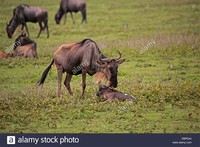
Young blue wildebeest are born tawny brown, and begin to take on their adult coloration at age nine weeks.

The name wildebeest derives from the Dutch and Afrikaans words wild and beest, which together mean "wild animal;" additionally, "beest" in Afrikaans means "cattle" (or "steer").

The blue wildebeest, which sometimes can be found in huge herds, particularly those migrating in the Serengeti of Tanzania, are key components of food chains in their ecosystems.

The black wildebeest or white-tailed gnu (Connochaetes gnou) is found mainly in east-central South Africa, particularly in eastern northern Cape and Free State (Taylor 2004).
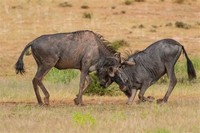
Blue wildebeest have a slight hump above the shoulders, a slight slope toward the rear, a black mane, and a flowing beard in both sexes (Taylor 2004).
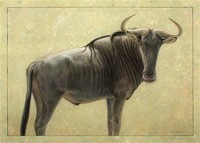
Wildebeest have a medium to large body, of somewhat stocky build, a long head, elevated shoulders, thin legs, and smooth, initially downward or outward curving horns, found in both sexes (Taylor 2004).

Afrikaners (Afrikaans-speaking South Africans) may have started using the name wildebeest for the animal as they had no other name for it when it was first encountered.
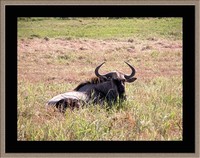
The Dutch name for wildebeest is gnoe (where the Dutch "g" is pronounced , as in loch).

Probably the most conspicuous feature of the blue wildebeest are the large horns shaped like parentheses, extending outward to the side and then curving up and inward.
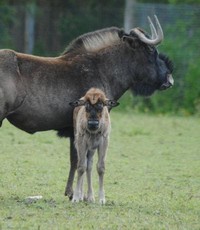
Existing populations of the black wildebeest are reintroductions from captive animals.

Humans have almost completely exterminated natural populations of the black wildebeest, killing them as a source of food and hides and further motivated by the desire to reserve grazing lands for cattle.

Connochaetes includes only two extant species, both native to Africa: The black wildebeest, or white-tailed gnu (C. gnou), and the blue wildebeest, or brindled gnu (C. taurinus).

The blue wildebeest is found in southern Kenya, Tanzania, and Zambia, south to Angola, Namibia, Botswana, and northeastern South Africa; it is extinct in Malawi (Taylor 2004).
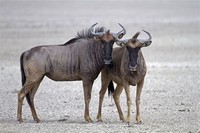
The Serengeti boasts over one million blue wildebeests, but Southern Africa's large herds have diminished over the last several centuries under pressure from hunting, cattle ranching, and habitat intrusion stemming from overpopulation of humans.

Wildebeest are antelopes, which are a diverse group of typically hollow-horned and swift bovids native to Africa and Asia.
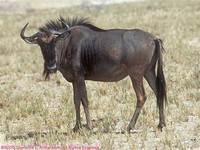
The blue wildebeest or brindled gnu (Connochaetes taurinus), also known as the blue and white-bearded wildebeest, is found in open and brush-covered savanna in south and east Africa.

Wildebeest grow to 3 ft 9 in–4 ft 7 in (1.15–1.4 meters) at the shoulder and weigh 330–550 pounds (150–250 kilograms).

The black wildebeest is characterized by a tuft of stiff hairs on the face.

Wildebeest generally graze on grass and blue wildebeest prefer to graze areas of short grass; the black wildebeest also will browse on plants during the winter (Taylor 2004).

Like almost all bovids, the wildebeest are social animals that live in groups, called herds.

Wildebeest typically are further classified as members of the subfamily Hippotraginae (grazing antelopes) and tribe Alcelaphini (Taylor 2004).
